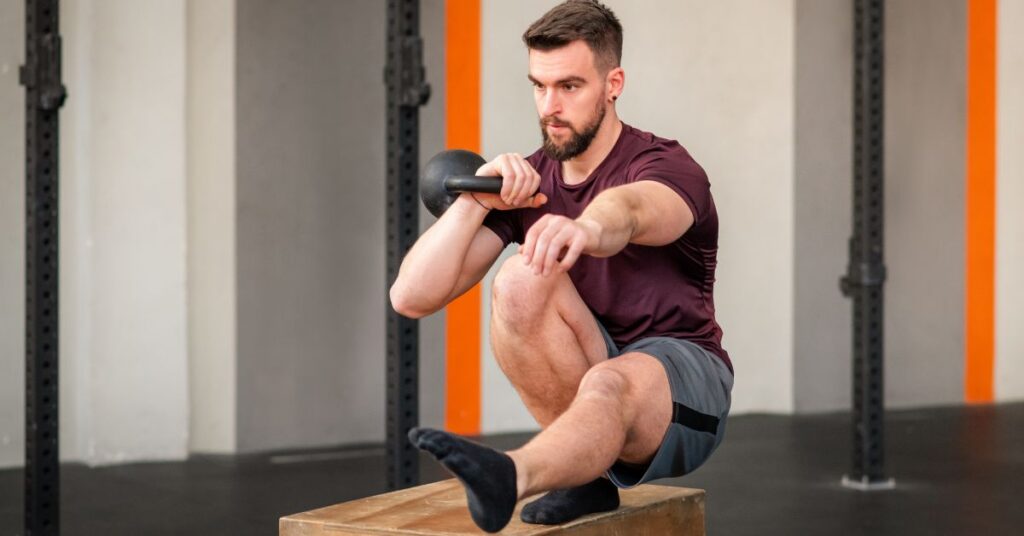Wide grip pull ups are a staple exercise in the fitness community, known for their effectiveness in building upper body strength and enhancing muscle definition. By positioning the hands wider than shoulder-width apart, this variation alters the mechanics of traditional pull-ups, targeting the back muscles more intensely. Whether you’re a beginner looking to develop strength or an advanced athlete aiming to refine your technique, understanding the nuances of wide grip pull ups is crucial. This page explores everything you need to know about this powerful exercise, from the muscles engaged to variations and workout routines.

What Are Wide Grip Pull Ups?
Lat-focused pulls are an advanced upper body exercise that primarily focuses on developing the latissimus dorsi, or lats, while also engaging the biceps, shoulders, and core. Unlike standard pull-ups, where the hands are positioned shoulder-width apart, broad grip exercises require the hands to be placed significantly wider. This shift in grip alters the movement mechanics, emphasizing different muscle groups and requiring greater upper body strength.
How to Do Wide-Grip Pullups?

Mastering expanded grip pull-ups requires attention to specific technical details:
- Bar Selection: Choose a bar that allows sufficient width without compromising shoulder comfort
- Grip Positioning: Place hands 6-10 inches wider than shoulder width with palms facing forward
- Starting Engagement: Begin from a dead hang with shoulders actively pulled down (not passively hanging)
- Body Alignment: Maintain slight hollow body position with ribs pulled down and core engaged
- Initiation Sequence: Start the movement by depressing shoulder blades before bending elbows
- Pull Pattern: Drive elbows downward and slightly backward while keeping chest proud
- Breathing Technique: Exhale during the pulling phase, inhale during the controlled descent
- Movement Tempo: Maintain a 2:1 ratio of lowering time to pulling time for optimal muscle development
- Top Position: Bring chin above bar without excessive neck extension
- Full Range: Return to complete arm extension between repetitions while maintaining shoulder control
This methodical approach ensures maximum muscle recruitment while minimizing injury risk.
Understanding the Mechanics of Wide Grip Pull Ups

To execute broad stance upper body pulls, start by grasping the pull-up bar with an overhand grip, palms facing away from you, at a distance greater than shoulder-width. This positioning creates a unique angle for muscle engagement. As you pull yourself up, the lats activate to perform shoulder adduction and extension, with the shoulders and core providing stability throughout the movement.
Why Choose Wide Grip Over Traditional Pull-Ups?
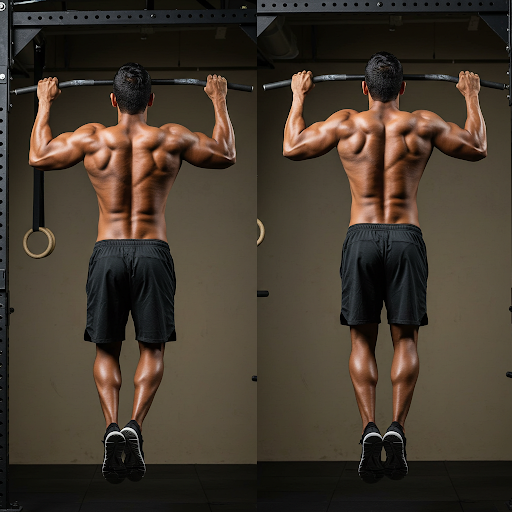
While both extended hand position and traditional pull ups are beneficial, the wider variation provides distinct advantages. The wider grip emphasizes the lats more effectively, leading to improved back development and strength. Additionally, the increased difficulty level can contribute to greater muscle growth and endurance as you progress. For those looking to enhance their upper body strength and aesthetics, this lat-dominant exercise is a valuable addition to any workout routine.
What Muscles are used in a wide-grip pullup?

The broad hand pull-up creates a unique pattern of muscle activation:
Primary Movers:
- Latissimus Dorsi: Maximum activation from horizontal adduction demands
- Teres Major: Extends and adducts shoulder joint with lats
- Rhomboids: Activate during scapular retraction
- Lower Trapezius: Stabilizes and depresses shoulder blades
Supporting Cast:
- Posterior Deltoids: Aid shoulder extension
- Biceps Brachii: Assist elbow flexion (less than in close-grip)
- Brachialis and Brachioradialis: Support elbow flexion
- Forearm Flexors: Maintain grip integrity
Stabilizers:
- Rotator Cuff Muscles: Maintain shoulder joint integrity
- Core Muscles: Prevent arching and control body position
- Serratus Anterior: Assists with scapular positioning
This comprehensive recruitment pattern explains why extended grip training delivers such remarkable upper back development.
Key Muscles Engaged
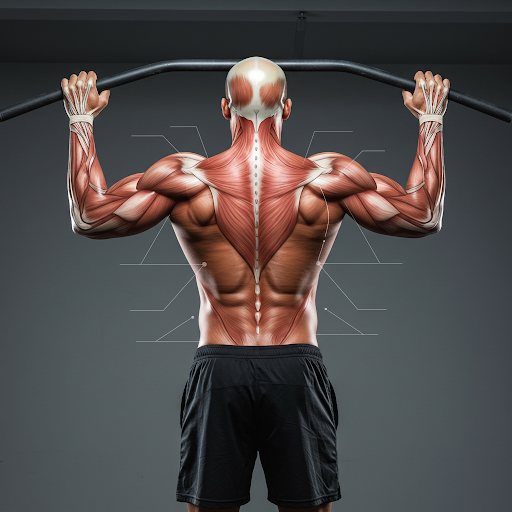
Wide grip pull-ups engage multiple muscle groups through precise activation sequencing, beginning with scapular depression and progressing to latissimus dorsi engagement. This compound movement enhances intermuscular coordination while strengthening the posterior chain, improving posture, and developing core stability—making it an unparalleled exercise for comprehensive upper body development.
1. Primary Muscles Targeted
- Latissimus Dorsi: The Star Player: The latissimus dorsi, the primary muscle worked during wide grip pull ups, is responsible for key movements like shoulder adduction and extension. This broad muscle runs from the lower back to the upper arm, and its engagement is crucial for pulling the body upward.
- Trapezius and Rhomboids: The trapezius and rhomboid muscles assist in stabilizing the shoulder blades during the pull-up motion. A well-developed trapezius not only aids in strength but also contributes to a well-defined upper back, which is aesthetically pleasing.
2. Secondary Muscle Engagement
- Biceps and Forearms : While wide grip pull ups place less emphasis on the biceps compared to closer grip variations, the biceps brachii still play a supporting role in elbow flexion. The forearms are actively engaged to maintain grip on the bar throughout the exercise, contributing to overall grip strength. You can understand its in-depth performance while exploring calisthenics biceps exercises.
- Deltoids and Teres Muscles: The deltoids provide stability during these back-focused movements, particularly in the shoulder joint. The major and minor muscles also assist with shoulder movement and stabilization, making them important players in the overall execution of wide stance pull-ups.
Benefits of Incorporating Wide Grip Pull Ups:

1. Enhanced Back Development for Aesthetics and Strength
Extended hand placement exercises are highly effective for developing a strong, well-defined back. By targeting the lats and upper back muscles, this exercise promotes muscle hypertrophy, resulting in improved aesthetics and functional strength.
2. Improving Grip Strength: A Functional Benefit
Regularly performing broad grip training enhances grip strength, which is crucial not just for pull-ups but for a variety of other exercises and daily activities. A strong grip supports better performance in weightlifting and sports, contributing to overall physical capability.
3. Core Engagement: More Than Just an Upper Body Exercise
This variation requires significant core stabilization, which helps to build core strength in addition to upper body development. A strong core is essential for overall fitness and supports a variety of movements, enhancing athletic performance and reducing injury risk.
4. Posture Correction through Back Strengthening
Incorporating lat-focused movements into your routine can improve posture by strengthening the muscles responsible for supporting the spine. A strong upper back counteracts the effects of prolonged sitting or slouching, leading to better alignment and reduced discomfort.
5. Caloric Burn: A Compound Movement’s Impact
As a compound movement engaging multiple muscle groups, broad stance pulls can contribute to a higher caloric expenditure during workouts. This makes them an effective addition to any fat loss or body composition program.
Tips for doing a perfect pull-up:

Creating the perfect pull-up requires attention to several critical elements:
Preparation Fundamentals:
- Develop shoulder mobility without impingement
- Master the active hang for scapular control
- Build grip strength through dedicated training
- Strengthen with horizontal rows before progressing
Technical Excellence:
- Begin with scapular depression before elbow flexion
- Keep elbows on consistent paths
- Eliminate leg kicking and body swing
- Control the lowering phase deliberately
- Maintain neutral neck alignment
Progressive Development:
- Use hollow body position for core engagement
- Practice negatives for full range strength
- Slow your tempo to eliminate momentum
- Prioritize quality over quantity
- Record and analyze your technique regularly
Remember: a perfect pull-up is less about reaching the bar and more about how you get there. The journey matters more than the destination when building functional strength.
How to Perform Wide Grip Pull Ups?
Wide grip pull-ups require proper technique to maximize muscle engagement and prevent injury. This comprehensive guide breaks down the movement into clear phases, helping you master this challenging but rewarding exercise.

Step-by-Step Instructions for Right Result:
Setting Up for Success
- Find a Sturdy Bar: Ensure the pull-up bar is secure and can support your weight.
- Grip the Bar: Use an overhand grip, positioning your hands wider than shoulder-width apart.
Executing the Pull-Up: Key Techniques
- Starting Position: Hang from the bar with your arms fully extended and your feet off the ground. Engage your core to stabilize your body.
- Pull-Up Motion: Initiate the movement by pulling your shoulder blades down and back. Bend your elbows, flaring them out as you pull your chest toward the bar.
- Top Position: Aim to bring your chin above the bar. Hold for a moment before lowering.
- Lowering Phase: Control the descent as you lower your body back to the starting position until your arms are fully extended.
Avoiding Common Mistakes
- Using Momentum: Relying on momentum reduces the exercise’s effectiveness. Focus on slow, controlled movements.
- Poor Grip: Ensure a strong grip on the bar to engage the correct muscles and prevent slipping.
- Neglecting Core Engagement: Always engage your core to maintain stability and proper form throughout the movement.
Important Tips for Wide Grip Pull Ups:
Mastering pull-ups requires attention to detail and proper progression strategies. These expert tips address the nuanced aspects of technique often overlooked by beginners and intermediate practitioners alike. By focusing on precise positioning, efficient movement patterns, and strategic progression, you’ll maximize both safety and results while developing impressive back strength and definition.
1. Start Position:
- Master the initial grip placement for wide grip pull-ups by positioning your hands approximately 6-8 inches wider than your shoulders. From my experience, this width optimally engages the outer lats while maintaining shoulder stability
- During the dead hang, actively pull your shoulders down and back before initiating wide grip pull-ups – this pre-engagement prevents excessive shoulder strain and sets up proper muscle activation
- Keep your wrists neutral and thumbs wrapped around the bar when performing wide grip pull ups, as this reduces forearm fatigue and enhances grip endurance
2. Execution Mechanics:
- Begin each rep of wide grip pull-ups by depressing your scapula first, imagine putting your shoulder blades in your back pockets before pulling
- Drive your elbows down and slightly back during wide grip pull-ups, rather than pulling straight down – this path maximizes lat engagement
- Focus on leading the movement with your elbows rather than thinking about pulling with your arms during wide grip pull ups
- Maintain a slight hollow body position (ribs down, core engaged) throughout the movement to prevent swinging
3. Progressive Technique:
- Start with negative-only wide grip pull-ups, taking 4-5 seconds to lower down, which builds eccentric strength needed for full reps
- When performing assisted wide grip pull ups, use resistance bands that allow you to complete 5-8 controlled repetitions
- Practice scapular pulls as a foundation before attempting full wide grip pull ups to develop proper back activation patterns
Safety Precautions for Wide Grip Pull Ups
While wide grip pull-ups deliver exceptional upper body development, they must be performed with appropriate safety measures to prevent injury and ensure long-term progress. These complete precautions address key areas of concern for practitioners at all levels, helping you train effectively while minimizing risk.
Joint Protection:
Safeguard your shoulders by prepping with mobility work and using a grip that respects your natural joint alignment.
- Warm up with 5-7 minutes of shoulder mobility work
- Reassess grip width if shoulders click or catch
- Keep elbows slightly in front of bar to reduce joint stress
Posture Requirements:
Good form isn’t optional- it’s protection. Monitor alignment and movement quality to prevent strain and maximize gains.
- Record side-view video to check forearm alignment
- Stop sets when full range of motion cannot be maintained
- Keep neck neutral with gaze slightly forward and up
Recovery Considerations:
Muscles grow during rest, not reps. Respect recovery windows and support shoulder health with targeted prehab work.
- Allow 48-72 hours between intense sessions
- Scale back volume if experiencing unusual shoulder fatigue
- Add rotator cuff exercises for shoulder health
Equipment Required:
- Test bar stability before beginning
- Ensure sufficient ceiling clearance
- Check grip width positioning each set
What are the alternatives to the overhead pullup?
When traditional pull-ups aren’t feasible, try these alternatives:
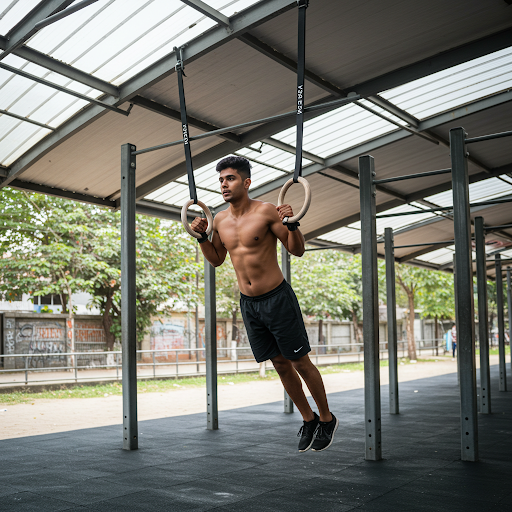
Horizontal Alternatives:
- Inverted Rows: Adjustable difficulty based on body angle
- Ring Rows: Provides rotational freedom for shoulders
- TRX Rows: Portable with adjustable intensity
- Doorway Towel Rows: Minimal equipment option
Vertical Pulling Alternatives:
- Lat Pulldowns: Machine-based with adjustable resistance
- Banded Pulldowns: Home-friendly using anchored bands
- Partner-Assisted Negatives: Focuses on lowering phase
- Jump-to-Hold Pull-ups: Controls descent from jumped position
Complementary Exercises:
- Straight-Arm Pulldowns: Isolates lats without elbow flexion
- Dumbbell Pullovers: Develops lats through shoulder extension
- Renegade Rows: Adds anti-rotation core stability
- Scapular Depression Holds: Builds initial pull-up strength
Use as developmental steps toward full pull-ups or during recovery from injuries.
Variations and Alternatives to Wide Grip Pull Ups:

Expanding your pull-up options with these variations allows for continued progress regardless of your current strength level. Each alternative offers specific benefits while maintaining the core mechanics that make wide grip pull-ups so effective for back development.
1. Assisted Wide Grip Pull Ups
Assisted pull-ups use resistance bands or machines to reduce the amount of bodyweight you need to lift. This makes the exercise easier while you build strength, allowing you to practice proper form before attempting full wide grip pull-ups. The assistance gradually decreases as you get stronger until you can perform the exercise unassisted.
- Equipment Setup
Secure resistance band evenly around pull-up bar, testing for stability. Choose band resistance allowing 6-8 controlled reps with proper form. Too many reps means band is too strong; too few means it’s too weak. Test with bounces before starting. Position stable platform for smooth entry/exit that supports your full weight.
- Starting Position Mechanics
Place knee or feet through band loop while maintaining hand position. Start with shoulder-width grip, then slide hands 3-4 inches wider. Create tension by pulling shoulders down and back before beginning. Position body in slight hollow hold with tucked pelvis, engaged core, and neutral spine to prevent arching.
- Movement Execution
Begin with scapular depression – shoulders away from ears with straight arms. Drive elbows down and slightly back during pull to maximize lat engagement while minimizing biceps work. Control ascent, taking 2-3 seconds to reach the top. Clear the bar with vertical movement, not neck craning. Exhale while pulling, inhale while lowering.
- Progressive Reduction
Track total assisted pull-up volume each workout. Reduce band assistance every 2-3 weeks when form remains strict. Decrease repetitions when switching to lighter bands, prioritizing quality over quantity. Graduate from band assistance after achieving 3 sets of 8 perfect reps with proper technique.
How to Build Up Strength for the Wide-Grip Pull-Up
Build strength systematically through four phases:
Foundation (Weeks 1-4): Master scapular depression holds, Australian rows with wide grip, dead hangs, active hangs, and hollow body holds.
Development (Weeks 5-8): Progress to negative pull-ups, isometric holds, band-assisted pull-ups, lat pulldowns, and elevated rows.
Refinement (Weeks 9-12): Add partial-range pull-ups, reduce band assistance weekly, practice cluster sets, weighted scapular work, and frequent sub-maximal sets.
Performance (Weeks 13-16): Attempt full pull-ups with perfect form, slower negatives, density training, and supportive exercises with video analysis.
This progression builds specific strength without creating compensation patterns or risking injury.
2. Weighted Wide Grip Pull Ups
Weighted pull-ups add extra resistance to the standard exercise by attaching weight to your body. This challenging variation is for those who can already perform multiple regular pull-ups with good form. By adding weight, you continue building strength even after bodyweight pull-ups become too easy, pushing your muscles to develop further.
- Equipment Requirements
Choose a proper dip belt with appropriate chain length that sits above hip level without riding up. Position weight centered between legs to prevent swinging. Start with 5% of bodyweight, focusing on form quality. Always verify equipment security, checking all connections before each set.
- Form Modifications
Create core tension by drawing ribs down and engaging abdominals throughout the movement. Maintain vertical alignment from hands to hips with deliberate control. Establish consistent breathing rhythm: inhale at bottom, exhale during pull. Monitor grip fatigue between sets and adjust hand position while maintaining proper width.
- Progressive Loading Protocol
Structure 4-6 week training cycles, starting each at 70% of previous maximum. Use 2.5-pound increments for steady progress. Alternate between volume-focused and intensity-focused weeks. Track performance metrics including reps, weight, and rest periods to guide progression and identify plateaus.
3. Negative Wide Grip Pull Ups
Negative pull-ups focus on the lowering phase of the exercise. You start at the top position (with your chin over the bar) and slowly lower yourself down. This variation is easier than full pull-ups but harder than assisted versions, making it an excellent stepping stone in your strength development. Controlling your descent builds the same muscles needed for complete pull-ups.
- Technical Execution Details
Establish proper hand placement and full shoulder engagement before beginning descent. Control the negative through distinct segments, pausing at 90-degree elbow flexion. Maintain constant lat tension by actively resisting gravity. Focus on scapular movement patterns: elevation at top, controlled depression during descent.
- Common Technical Refinements
Build grip endurance through forearm training before progressing to longer-duration negatives. Eliminate swinging by maintaining vertical shin position. At the bottom, actively reach tall through shoulders while maintaining depression. Monitor elbow tracking throughout the movement, avoiding excessive flaring.
- Programming Implementation
Start with 4-5 sets of 3-4 quality negatives. Allow full recovery with 2-3 minute rest periods between sets. Supplement with exercises targeting scapular control and lat activation. Progress by increasing time under tension from 4 seconds initially to 8-10 seconds per repetition.
Wide grip vs. close grip
Aspect | Wide Grip | Close Grip |
Primary Muscles | Upper/outer lats, lower traps, rhomboids | Biceps, brachialis, teres major, rear delts |
Range of Motion | Limited at top position | Greater, with more scapular retraction |
Shoulder Position | Greater abduction, higher joint stress | More neutral, typically shoulder-friendly |
Training Benefits | Back width, V-taper aesthetic | Overall pulling strength, skill transfer |
Difficulty Level | More challenging (mechanical disadvantage) | Better leverage for beginners |
Best For | Back width development, lat focus | Arm strength, shoulder health, beginners |
Optimal approach: Incorporate both variations strategically throughout training cycles to maximize development and minimize overuse patterns.
Comparing Wide Grip and Close Grip Pull Ups
Understanding the differences between pull-up variations helps you choose the right exercise for your specific goals and current fitness level. This comparison highlights key distinctions that will inform your training decisions.
- Muscle Engagement Differences
Broad hand placement exercises primarily target the lats and upper back, while close grip pull ups engage the biceps more effectively due to the closer hand placement. This means that the wider variations are more focused on back development, making them ideal for those aiming for a V-taper look.
- Evaluating Difficulty Levels: Which is Right for You?
Extended grip movements are generally more challenging than their close grip counterparts, as they require greater strength and stability in the upper back without the additional assistance from the biceps. For beginners, starting with close grip pull-ups or assisted variations may be more beneficial until strength is developed.
Bored Of Pull Ups? Pull Up Alternatives
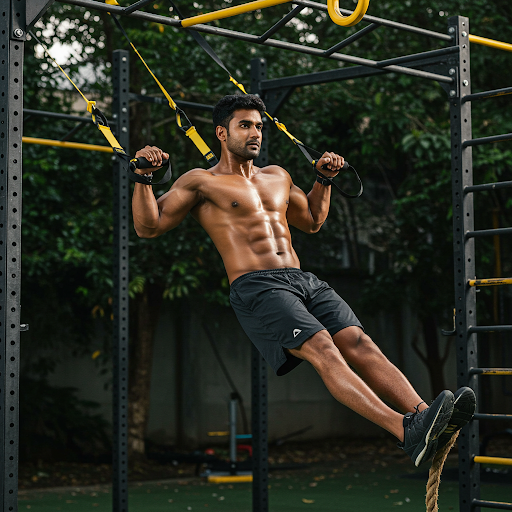
When aiming to diversify your upper body training routine and reduce repetitive strain, exploring alternatives to traditional and wide grip pull ups can be highly beneficial. These variations not only mimic similar movement patterns but also introduce new levels of difficulty, stimulate different muscle fibers, and support continued strength progression without overloading the same joints.
Category | Variation | Description |
Dynamic Variations | Archer Pull-ups | Shift body weight toward one arm while other extends laterally |
Around-the-World Pull-ups | Circular movement pattern creating new resistance angles | |
Typewriter Pull-ups | Maintain top position while shifting horizontally along bar | |
Clapping Pull-ups | Explosive concentric phase with momentary bar release | |
Grip Variations | Towel Pull-ups | Grip towels hung over bar for intense forearm development |
Rope Climbs | Vertical pulling with alternating arms and lower body involvement | |
L-Grip Pull-ups | Use perpendicular bars for neutral grip changing resistance angle | |
False Grip Pull-ups | Preliminary position for muscle-up transition training | |
Leveraged Movement Patterns | L-Sit Pull-ups | Maintain extended legs parallel to ground throughout movement |
Weighted Pull-ups | Add external load via weight belt or weighted vest | |
Archer Rings Pull-ups | Unilateral emphasis with rotational freedom on rings | |
One-Arm Pull-up Progressions | Ultimate expression of pulling strength | |
Skill Development | Muscle-ups | Combine pull-up with transition to dip position above bar |
Front Lever Progressions | Horizontal body position focusing on core strength | |
Back Lever Variations | Face-up horizontal position requiring unique strength pattern | |
Pegboard Climbing | Dynamic traversing requiring grip strength endurance |
These alternatives not only combat training boredom but also develop more comprehensive upper body strength by challenging familiar movement patterns with new mechanical demands.
Sample Workout Routines Featuring Wide Grip Pull Ups

Beginner-Friendly Workout Plan
- Assisted Broad Hand Placement Pulls: 3 sets of 5-8 reps
- Inverted Rows (Wide Grip): 3 sets of 8-10 reps
- Plank Holds: 3 sets of 30 seconds
Intermediate Challenge Routine
- Expanded Grip Exercises: 4 sets of 6-10 reps
- Chin-Ups (for variety): 3 sets of 6-8 reps
- Bodyweight Rows (under a bar): 3 sets of 8-12 reps
Advanced Workout for Seasoned Lifters
- Weighted Lat-Focused Pulls: 4 sets of 4-6 reps
- One-Arm Assisted Pull-Ups (using bands): 3 sets of 3-5 reps per arm
- Commando Pull-Ups (alternating sides): 3 sets of 5-8 reps
How to Master The Wide Grip Pull-Up?
Achieving mastery in wide grip pull ups requires more than just reps- it demands precision, smart programming, and dedicated recovery. Here’s how to level up effectively:
Precision Technique:
- Focus on one technical aspect per workout
- Analyze form with video from multiple angles
- Practice deliberate muscle activation
- Use paused reps at difficult positions
Progressive Programming:
- Cycle between strength, hypertrophy, and endurance
- Alternate weighted and bodyweight sets
- Vary grip width, tempo, and volume
- Track metrics to identify plateaus
Advanced Loading:
- Cluster sets: 2 reps, 15s rest, 5 clusters
- Add bands for variable resistance
- Pre-fatigue with isolation before compounds
- Use partner assistance for eccentric overload
Recovery:
- Deload every 4-6 weeks
- Implement cold-hot contrast therapy
- Prioritize quality sleep
- Address restrictions with targeted soft tissue work
Conclusion
Broad hand placement pull-ups are not just an exercise; they are a powerful tool for transforming upper body strength. By incorporating this movement into your routine, you can achieve significant improvements in muscle definition, functional strength, and overall fitness levels. Whether you’re aiming to enhance your physique or boost your athletic performance, wide grip training is an essential component of any comprehensive training program.
If you’re serious about mastering wide grip pull ups and want expert support to improve your technique, strength, and recovery, connect with the professionals at ISC – Indian School of Calisthenics. Their certified coaches offer personalized training programs tailored to your fitness level, whether you’re a beginner or looking to break through plateaus. For one-on-one coaching, group sessions, or detailed progression plans, visit them at ISC – Indian School of Calisthenics, SRPF Ground, NH8, Goregaon (E), Mumbai – 400065 or call +91 77159 53218.
Wide-grip pull-ups - FAQs
How often should I do wide grip pull ups?
It’s generally recommended to perform wide grip pull-ups 2-3 times a week, allowing for adequate recovery between sessions.
Can beginners perform wide grip pull ups?
Yes, beginners can start with assisted wide grip pull-ups or negative pull-ups to build strength before progressing to full pull-ups.
How can I improve my wide grip pull-up performance?
Focus on building overall upper body strength through complementary exercises, maintaining proper form, and gradually increasing the number of repetitions and intensity.
Are wide grip pull ups suitable for everyone?
While they are beneficial for many, individuals with shoulder or back issues should consult a fitness professional or healthcare provider before attempting this exercise.
What's the best way to incorporate wide grip pull ups into my workout routine?
Integrate wide grip pull-ups into your upper body workout as a primary exercise, and combine them with other back, shoulder, and core strengthening exercises for balanced training.
What muscles do wide grip pull ups primarily target?
Wide grip pull ups mainly work the latissimus dorsi, teres major, rhomboids, and trapezius, with support from the biceps, rear deltoids, and core stabilizers.
What’s the ideal grip width for wide grip pull ups?
An ideal grip is about 6–10 inches wider than shoulder-width. Going too wide can limit range of motion and increase shoulder strain, especially if you lack mobility.
Should I do wide grip pull ups before or after other back exercises?
For most lifters, it’s best to perform wide grip pull ups early in your workout when your upper body is fresh, as they require more strength and stability than machine or isolation movements.
Are wide grip pull ups better than regular pull ups?
Not necessarily better—just different. Wide grip pull ups emphasize lat width and upper back more, while standard pull-ups offer a balanced engagement of both the lats and biceps with a fuller range of motion.
How can I prevent shoulder pain while doing wide grip pull ups?
Ensure proper warm-up with shoulder mobility exercises, avoid excessively wide grips, maintain scapular control throughout the movement, and allow sufficient rest between sessions to reduce shoulder strain.

